Wizards of the Coast had an "accidental" extra release of Fourth Edition.
After several early sets, Wizards of the Coast decided to go from their printer since day one, the Belgium-based Cartamundi, to a new U.S.-based printer in 1995. After selecting The United States Playing Card Company in Cincinnati, everything seemed to be good and ready to go for printing the game's Fourth Edition set in time for it's April 1995 release.
The company went all out.
Akin to the aborted Sixth Edition changes a few years down the line, the Fourth Edition they were planning looked to have some radical changes. Noticeable counterfeiting measures were added on, including a special UV coating. This made the cards very glossy, similar to baseball cards or casino-quality playing cards. In addition to fighting fraud, any sun discoloring would also be halted thanks to the coating. And, unlike the counterfeit Magic cards of the time, if placed under a UV light, they would immediately be known. While this is now pretty standard practice now, back in 1995 this was the future. Closeups on the cards even reveal clear images, with rosette printing replaced by dots.

The card printing company sent a bunch of samples back to WotC HQ in the Seattle area and was expecting a quick "yes" for a full production order. However, despite being happy later on with Vampire: The Eternal Struggle and it's expansion, Dark Sovereigns, in late 1995 and 1996, the Fourth Edition cards were simply not up to snuff. Thankfully for WotC, only a smattering of the cards managed to get out in back stock form -mostly in the Midwest - before everything was halted. The new cards simply weren't up to their standards. Plus, for players who didn't use sleeves (which was almost everybody at the time), it could be readily apparent from which edition the new, shinier cards came from. Quality control aside, this could also open the door to widespread cheating were more of these newly printed cards to become available.
 This led to a dispute between WotC and The United States Playing Card Company which was ended in an undisclosed settlement sometime later. While both sides tried to destroy all the cards printed, many managed to make it out into the public and they are currently still out there somewhere today.
This led to a dispute between WotC and The United States Playing Card Company which was ended in an undisclosed settlement sometime later. While both sides tried to destroy all the cards printed, many managed to make it out into the public and they are currently still out there somewhere today.
This alternate printing of Fourth Edition thus became something of an urban legend for the next seven years until Magic: The Gathering pro player Dan Bock managed to uncover what really happened in 2002. WotC seemed to say nothing much at all on the subject until 2016 when Mark Rosewater finally acknowledged the print run's existence, still maintaining that no cards ever made it out despite cards and even entire starting decks being sold online. They're pricy too - entire starting decks can run you upwards of $400 nowadays.
Why was WotC so cagey about a Magic: The Gathering printing that probably shouldn't have existed in the first place? Well, besides it ending in a settlement which may or may not be legal to talk about, it was a bit of a headache to scrap an entire print run because of the quality. Wizards of the Coast wound up learning from that mistake, as well as previous card printing errors like the accidental Wyvern cardbacks found on some Fallen Empires cards, and returned to having Magic cards printed at Cartamundi for most all future releases.
As fate would have it, Cartamundi would purchase The United States Playing Card Company in June of 2019.









